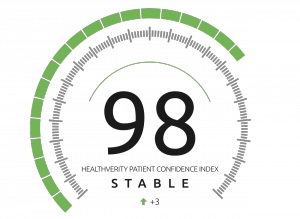HVPCI reports “98” and marks six-month milestone of patient monitoring amid COVID-19 pandemic
HealthVerity announced the most recent update to its HealthVerity Patient Confidence Index (HVPCI) and reported a national score of 98, a three-point increase.
PHILADELPHIA, PA, UNITED STATES, October 20, 2020 /EINPresswire.com/ -- HealthVerity announced the most recent update to its HealthVerity Patient Confidence Index (HVPCI) and reported a national score of 98, a three-point increase from the previous period and the highest level to date. After 6 months of reporting on patient confidence in returning to traditional doctor’s visits in light of the pandemic, this score reflects the sixth index to fall within “stable” levels noting a continued positive pattern for US patients seeking care across all major therapeutic areas.
The HVPCI represents a measure of physician visits undertaken by non-COVID-19 patients across 20 key therapeutic areas, highlighting a significant decline in visits since the pandemic took hold in the US at the beginning of March. The HVPCI is crucial as an expression of the confidence in patients to seek care for acute and chronic illnesses balanced with the risk of exposure to the coronavirus in a public setting. As coronavirus cases peak and eventually subside, this indicator will ultimately serve as an overall measure of US patient engagement between patients and their physicians.
This period’s national score of 98 not only reflects the highest score to date since the onset of COVID-19, but also marks the first time that five of the major specialties see patient engagement above or meeting the “normal” threshold of 100. Family and general practice (100), gastrointestinal and genitourinary (GI & GU) (109), infectious disease (116), pediatrics (115) and preventive med (110) all rendered scores higher than last period, but only infectious disease is surpassing the rates of 2019.
Countering the positive uptick for most specialties is the trend seen for oncology (88) which reported the lowest score since late June 2020. This score and the negative decline seems to further prove the issue of many Americans avoiding oncology screenings and other cancer-related lifesaving procedures amid the pandemic. “There’s really almost no way that doesn’t turn into increased mortality,” with the full effects likely to play out over a decade, said Norman E. “Ned” Sharpless, director of the National Cancer Institute. Missed screenings and other pandemic-related impacts on care could result in about 10,000 additional deaths from breast and colon cancer alone over the next 10 years, the NCI projected earlier this year. Dr. Sharpless said the estimate now appears low.
Telehealth visits declined for the tenth straight period with total share of visits at its lowest to date, accounting for only 8%. At the height of the pandemic, telehealth visits hovered around 20% compensating for the lack of willingness by patients to attend their doctor’s visits in person. Endocrinology, pulmonology and rheumatology represent the areas where telehealth still remains at an elevated level especially for patients within the age groups of 51-64 and 64+. As mentioned in the last couple of index reports, the colder weather and unfortunate drift into flu season may again elevate telehealth at levels seen in April and May of this year, but only the data will tell.
Learn more about HealthVerity’s efforts to educate and inform on COVID-19 here.
Abby Stockwell
HealthVerity
+1 8565627413
astockwell@healthverity.com
Visit us on social media:
LinkedIn


